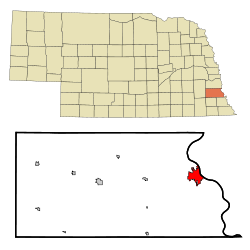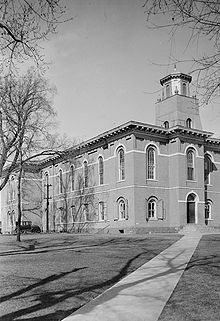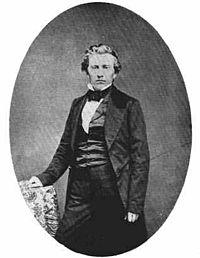- Nebraska City, Nebraska
-
Nebraska City, Nebraska — City — Location of Nebraska City, Nebraska Coordinates: 40°40′34″N 95°51′35″W / 40.67611°N 95.85972°WCoordinates: 40°40′34″N 95°51′35″W / 40.67611°N 95.85972°W Country United States State Nebraska County Otoe Area – Total 4.4 sq mi (11.5 km2) – Land 4.4 sq mi (11.5 km2) – Water 0.0 sq mi (0.0 km2) Elevation 1,056 ft (322 m) Population (2000) – Total 7,228 – Density 1,633.6/sq mi (630.7/km2) Time zone Central (CST) (UTC-6) – Summer (DST) CDT (UTC-5) ZIP code 68410 Area code(s) 402 FIPS code 31-33705[1] GNIS feature ID 0831570[2] Nebraska City is a city in Otoe County, Nebraska, United States. The population was 7,228 at the 2000 census. It is the county seat of Otoe County.[3] Nebraska City is home of Arbor Day, the Missouri River Basin Lewis and Clark Center (which focuses on the natural history achievements of the expedition), and the Mayhew Cabin, the only site in the state recognized by the National Park Service as a station on the Underground Railroad. The Park Service includes it as a destination in its Underground Railroad Network to Freedom Program.
The Nebraska State Legislature has credited Nebraska City as being the oldest incorporated city in the state, as it was the first approved by a special act of the Nebraska Territorial Legislature in 1855.[4]
Contents
History
Early European-American official exploration was reported in 1804 by Lewis and Clark as they journeyed west along the Missouri River. They encountered many of the historic Native American tribes whose ancestors had inhabited the territory for thousands of years.
During the years of early pioneer settlement, in 1846 the US Army built Old Fort Kearny at Nebraska City. Several years later, the army abandoned it to relocate the fort to central Nebraska, now south of present-day Kearney.
Shortly after the post was vacated, John Boulware developed an important river-crossing and ferry service from Iowa to present-day Nebraska City. He and his father expanded their business and in 1852 or 1853 built a ferry house, the first residence in Nebraska City. The city became a site of a slave market in the 1850s.[5]
In 1854 the Kansas-Nebraska Act allowed legal settlement in the regional area. Three townships were incorporated by settlers: Nebraska City and Kearney City were incorporated in 1855, and South Nebraska City was incorporated in 1856. During those years, Nebraska City competed fiercely to become the Nebraska Territory capital. On December 31, 1857, these three town sites along with Prairie City joined, incorporating as present-day Nebraska City. Before the American Civil War, Nebraska City was noted as having the Territory's largest population of slaves. Many worked on the riverfront as laborers, involved with moving freight and luggage associated with steamboat traffic.
By the mid-19th century, steamboats on the Missouri River were the vitalizing force behind Nebraska City’s growth - bringing commerce, people and freight to the west. In the spring of 1858 Russell, Majors and Waddell started freighting from Nebraska City on a government contract to transport all provisions for all western forts. The supplies were brought up the Missouri River by steamboat and then taken out by wagon train. Nebraska City's favorable position (with a gradual slope from the river to the table land above) and good trail made it an important link to the west.
Since that beginning, the city became established as a regional transportation, economic, and agriculture hub for the three state area. Additional forms of transportation were important, including the steam wagon and the first locomotive engine of the Midland Pacific.
J. Sterling Morton came to Nebraska City in 1855 to edit the Nebraska City News. Originally from Michigan, he and his wife Caroline were lovers of nature. Morton served as Secretary of Agriculture under President Grover Cleveland’s administration and in 1872 he was instrumental in establishing the annual tree planting day, Arbor Day. Governor Robert Furnas of Nebraska issued the first Arbor Day Proclamation on March 31, 1874. The holiday is celebrated around the world.
Geography
Nebraska City is located at 40°40′34″N 95°51′35″W / 40.67611°N 95.85972°W (40.676247, -95.859659),[6] on the western bank of the Missouri River.
According to the United States Census Bureau, the city has a total area of 4.4 square miles (11 km2), all land.
Nebraska City has its own hospital, St Marys Hospital. As the county seat, it has the courthouse and associated county offices.
Demographics
As of the census[1] of 2000, there were 7,228 people, 2,898 households, and 1,872 families residing in the city. The population density was 1,633.6 people per square mile (631.4/km²). There were 3,154 housing units at an average density of 712.8 per square mile (275.5/km²). The racial makeup of the city was 96.00% White, 0.37% African American, 0.30% Native American, 0.37% Asian, 0.07% Pacific Islander, 2.01% from other races, and 0.87% from two or more races. Hispanic or Latino of any race were 4.40% of the population.
There were 2,898 households out of which 31.0% had children under the age of 18 living with them, 51.3% were married couples living together, 10.2% had a female householder with no husband present, and 35.4% were non-families. 30.7% of all households were made up of individuals and 16.1% had someone living alone who was 65 years of age or older. The average household size was 2.40 and the average family size was 3.01.
In the city the population was spread out with 25.8% under the age of 18, 7.4% from 18 to 24, 25.4% from 25 to 44, 22.3% from 45 to 64, and 19.0% who were 65 years of age or older. The median age was 39 years. For every 100 females there were 89.9 males. For every 100 females age 18 and over, there were 85.0 males.
The median income for a household in the city was $34,952, and the median income for a family was $42,860. Males had a median income of $29,507 versus $19,859 for females. The per capita income for the city was $16,969. About 6.3% of families and 9.3% of the population were below the poverty line, including 12.0% of those under age 18 and 7.7% of those age 65 or over.
Arbor Day
Nebraska City is known as "The Home of Arbor Day". In Nebraska City is Arbor Lodge, home of the first Secretary of Agriculture of the United States, J. Sterling Morton, who promoted the planting of trees on the prairie for shade, fruit, and windbreaks. The National Arbor Day Foundation has its headquarters near his home in Nebraska City.[7]
Area schools
- Nebraska City Public Schools - Home of the Pioneers; an NSAA Class B school in the Eastern Midland Conference.
- Lourdes Central Catholic Schools - Home of the Knights.
Notable natives and residents
- Monroe Leland Hayward — United States Senator from Nebraska and grandfather of Leland Hayward
- Leland Hayward — Hollywood and Broadway agent, and theatrical producer
- George H. Heinke — lawyer and US Congressman (1939–1940).
- John Henry Kagi — second in command in John Brown's 1859 raid on the US Arsenal at Harper's Ferry and created station at the Mayhew Cabin for the Underground Railroad.
- J. Sterling Morton — founder of Arbor Day and former US Secretary of Agriculture under President Grover Cleveland.
- Pete Ricketts — former Chief Operating Officer of Ameritrade. He was the Republican nominee for the 2006 U.S. Senate race in Nebraska.
- Joy Morton - Son of J. Sterling Morton; namesake of Morton Salt.
- Paul Morton- Son of J. Sterling Morton and younger brother of Joy Morton. From 1904-1905 he served as Secretary of the Navy under Theodore Roosevelt. Previous to this, he had been vice president of the Santa Fe Railroad.
See also
References
- ^ a b "American FactFinder". United States Census Bureau. http://factfinder.census.gov. Retrieved 2008-01-31.
- ^ "US Board on Geographic Names". United States Geological Survey. 2007-10-25. http://geonames.usgs.gov. Retrieved 2008-01-31.
- ^ "Find a County". National Association of Counties. http://www.naco.org/Counties/Pages/FindACounty.aspx. Retrieved 2011-06-07.
- ^ (1912) Bulletin. Issues 2. Nebraska State Legislature. p. 7.
- ^ [1]
- ^ "US Gazetteer files: 2010, 2000, and 1990". United States Census Bureau. 2011-02-12. http://www.census.gov/geo/www/gazetteer/gazette.html. Retrieved 2011-04-23.
- ^ [2]
External links
- Historic Nebraska City
- Nebraska City Community Foundation
- Nebraska City Area Economic Development Corporation
- KNCY, Nebraska City Radio
- Nebraska City News-Press
Municipalities and communities of Otoe County, Nebraska County seat: Nebraska CityCities Nebraska City | Syracuse
Villages Categories:- Cities in Nebraska
- Populated places in Otoe County, Nebraska
- County seats in Nebraska
- Nebraska populated places on the Missouri River
Wikimedia Foundation. 2010.




